Universal Credit Statistics: 29 April 2013 to 9 July 2020
Published 11 August 2020
Applies to England, Scotland and Wales
The latest release of these statistics can be found in the Universal Credit statistics collection.
This bulletin contains statistics on claims made, starts, people and households including payments for Universal Credit in England, Scotland and Wales (Great Britain).
The statistics released with this bulletin include claims made and starts to 9 July 2020, and the number of people on Universal Credit at 9 July 2020. Statistics for households are up to May 2020, and include payments made to new claimants in the initial period of the Coronavirus (COVID-19) pandemic.
Households data is not available earlier because data is incomplete due to assessment period timings. In addition, time is allowed for retrospection to the data for better quality statistics. For more information and on the timeliness of the statistics, please see the background information and methodology document.
Release schedule
The bulletin is published quarterly in February, May, August and November, supplemented by monthly data updates for people on Universal Credit in Stat-Xplore.
Next release of people on Universal Credit: 15 September 2020
Next release for claims, starts and households on Universal Credit: 10 November 2020
All releases can be found in the collection of Universal Credit statistics.
Other statistics
Similar statistics on Universal Credit for Northern Ireland are produced by the Department for Communities (Northern Ireland). Further statistics for Universal Credit are listed at the end of this bulletin.
Status
Universal Credit statistics are official statistics that are experimental. This is due to the ongoing development of the data systems that are used to support Universal Credit.
Revision
Revision to postcode area data for claims made and starts for the period 13 March 2020 to 9 April 2020.
Postcode data for claims made and starts was not available for over 90% of claims in the data extract used to produce the claims made and starts for the period of 13 March 2020 to 9 April 2020 published in May 2020. This data is now available and the postcode data has been revised. For more information, please see the statistical notice published alongside this bulletin.
Guidance
Guidance on these statistics is available in the background information and methodology document.
Geography data for People on Universal Credit and Households on Universal Credit
Geography data used in People on Universal Credit and Households on Universal Credit in this publication is based on the address information held by DWP before the coronavirus pandemic. An update to the address held in the central data source from which geography information is taken has been deferred until changes can be verified. This is most likely to affect new claimants who did not have recent contact with DWP before the coronavirus pandemic.
This does not affect the address information held on the Universal Credit full service that the claimant has declared on their claim. Postcode area on the Claims made to Universal Credit and Starts to Universal Credit data are not affected by this issue as they are obtained from the Universal Credit full service data.
Ethnicity and religion
We have added some extra background and clarification to explain why the ethnicity and religion information for Universal Credit claimants is not available. It can be found in our background information and methodology document.
Postcode district for claims and starts to Universal Credit has been withdrawn
This is due to an issue with the underlying data. Postcode districts (for example, E5) will be restored when a new methodology is developed. This does not affect postcode area (for example, ‘E’ in the postcode E5) for claims and starts which remains available.
Non-media enquiries on Universal Credit statistics: team.ucos@dwp.gov.uk.
1. Data tools accompanying this release
This bulletin presents commentary on the latest Universal Credit statistics. Alternative ways to view Universal Credit statistics are available:
- Stat-Xplore allows users to explore Universal Credit data and build their own tables. It also contains some ready-made tables
- Universal Credit claimants at Jobcentre Plus office level in an interactive map
- Households on Universal Credit at local authority level in an interactive map
- an interactive dashboard of the latest Universal Credit household statistics by region
2. Main stories
Claims made to Universal Credit
Claims made have reduced to 240,000 in the 4 weeks to 9 July 2020, returning to pre-pandemic levels following a sharp increase at the beginning of the coronavirus pandemic.
Starts to Universal Credit
- There were 2.4 million starts to Universal Credit between the 13 March 2020 and 14 May 2020, the first 2 months after lockdown started
- Young people make up a greater proportion of starts than before the coronavirus pandemic. The proportion of claimants starting on Universal Credit aged 16 to 19 year old (9.2%) and 20 to 24 year old (20.5%) has increased in July 2020 compared with March 2020 (6.7% and 14.4% respectively) at the beginning of the coronavirus pandemic
People on Universal Credit
On 9 July 2020:
- there were 5.6 million people on Universal Credit at 9 July 2020, an increase of 2% from 11 June 2020
- around 42% of claimants were in the ‘Searching for work’ conditionality group, an increase of 6 percentage points since March 2020
Households on Universal Credit
For the assessment period covering the 14 May 2020:
- there were 4.2 million households on Universal Credit, an increase of 1.7 million compared with February 2020
- of these, 88% (3.7 million) received a payment, compared with 94% in February 2020
For the assessment period covering the 9 April 2020:
- 96% of new claims received their full payment in full and on time, compared with 88% in March 2020
- 98% of all claims received their full payment in full and on time, compared with 96% in March 2020
3. Things you need to know
Management Information
To meet user needs for more timely information during the coronavirus (COVID-19) pandemic, the DWP published weekly management information on the number of declarations (claims) and advances. The first of these time limited management information releases was published on 21 April 2020 and were published weekly until the end of June.
There are methodological differences between the management information for ‘declarations (claims)’ and ‘claims made to Universal Credit’ in official statistics which mean that the two series are not comparable.
More information is given in the section on claims made to Universal Credit and in the background information and methodology document.
What is Universal Credit?
Universal Credit is a single payment for each household to help with living costs for those on a low income or out of work. It is replacing six benefits, commonly referred to as the legacy benefits.
Support for housing costs, children and childcare costs are integrated into Universal Credit. It also provides additions for people with a disability, health condition or caring responsibilities which may prevent them from working.
Universal Credit has been rolled out in stages:
- March 2013 to December 2017: Universal Credit was available to new claimants in a limited group, mostly to 18 to 60 year old single people with no children, unemployed (typically people who would have claimed income-related Jobseekers Allowance) where the Universal Credit live service was available. Where their circumstances changed they could remain on Universal Credit
- April 2016 to December 2018: Gradual roll out of Universal Credit full service. Where available, Universal Credit is available to new claims and people on legacy benefits whose circumstances change.
- December 2018: Universal Credit full service is available in every area of Great Britain
Read the background information and methodology document for a more detailed timeline.
Data sources and limitations
These official statistics have been compiled using data in systems used by the department in the administration of Universal Credit and records of Universal Credit benefit payments made by the department.
While every effort is made to collect data to the highest quality, as with all administrative data it is dependent on the accuracy of information entered into the system. Checks are made throughout the process from collection of the data to producing the statistics, but some data entry or processing errors may filter through to the data used to produce the statistics.
As Universal Credit continues to develop, caution should be used when interpreting statistics over long time periods. Administrative system changes could cause discontinuities in the time series that were not the result of a policy decision or the economic environment.
There are inherent differences in the data for People on Universal Credit and Households on Universal Credit, thus it is not possible to cross-tabulate between the two measures. More information is provided in the relationship between people and households on Universal Credit section of these differences between the two datasets.
A full discussion of strengths and limitations is in the background information and methodology.
Count date
Statistics for people on Universal Credit are based on the count of people on the second Thursday of each month, referred to as the count date. This date is determined by the date used for the Claimant Count which some of these data feed into. For this publication the latest count date is the 9 July 2020.
Claims and starts are based on the total flow between the day after the count date for the previous month up to the count date.
Household statistics are based on the assessment periods that overlap the count date. A longer time period is required before publishing statistics for households than statistics for people, claims and starts because data for payment information for households is subject to more retrospection.
The background and methodology document provides more information on the process of producing these statistics.
4. Claims made to Universal Credit
Making a claim is the first step an individual will need to do to receive Universal Credit. Not everybody that makes a claim will go on to start on Universal Credit.
Claims made reduced gradually from the peak of over 550,000 in the week ending 26 March 2020, and are now at similar levels to before the coronavirus pandemic.
These figures differ to earlier published management information. To provide timely information on the volume of claims being made to Universal Credit, the DWP published management information that was an initial view of what was recorded on the administrative system. To provide this management information in a timely manner it cannot be produced with the same level of quality assurance and to the same methodology as used in official statistics.
The number of claims made to Universal Credit per week falls sharply from April 2020 to July 2020
Figure 1: Claims made (weekly), 10 January 2019 to 9 July 2020
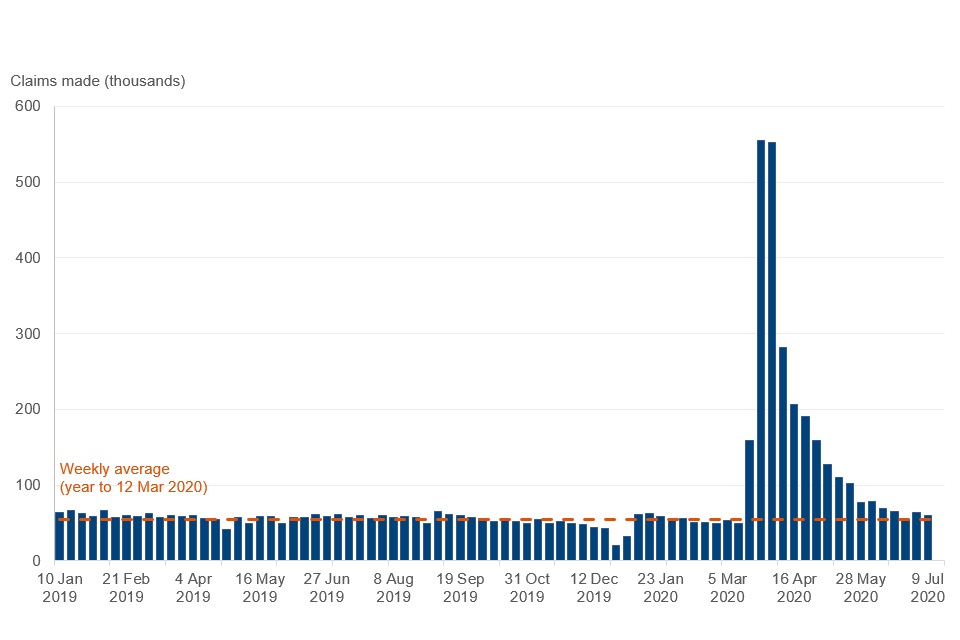
Source: DWP Universal Credit statistics.
Note: See Stat-Xplore for the complete data series.
The restrictions that were introduced throughout the country as a result of the coronavirus (COVID-19) pandemic led to a sharp increase in the number of claims for Universal Credit.
Claims made started to increase in the week prior to the government announcing that all non-essential travel must stop. During the first 2 weeks of the ‘lockdown’ there were over 500,000 claims a week, more than 9 times the usual level of claims made in a week. (figure 1).
Claims made remained high, although at lower levels in the following weeks, gradually reducing week on week. They have now returned to levels similar to before the coronavirus pandemic with 240,000 in the 4 weeks to 9 July 2020.
Increased number of claims made during the initial period of the lockdown
Figure 2: Claims made (daily), 28 February 2020 to 9 July 2020
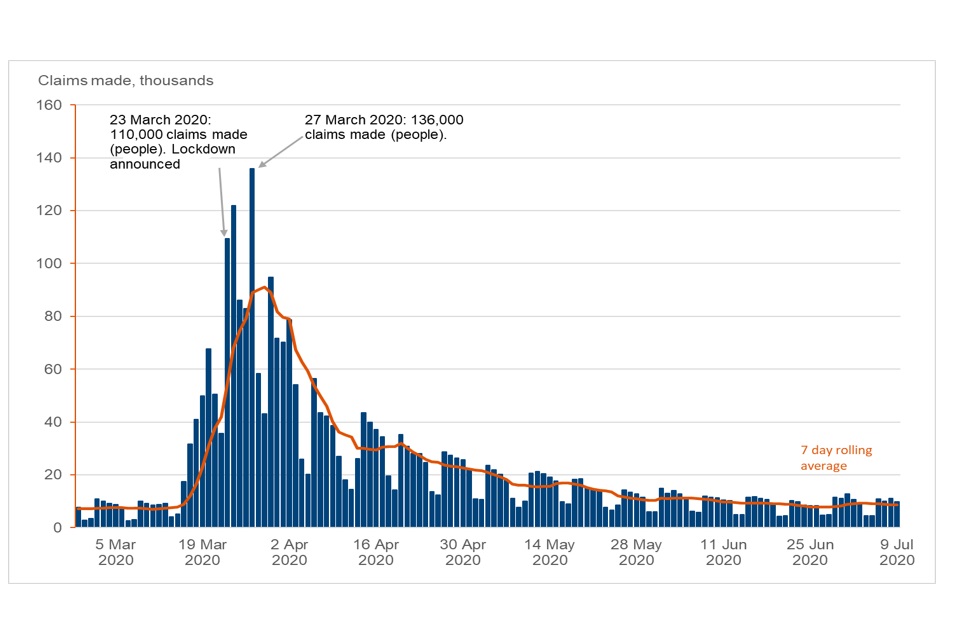
Source: DWP Universal Credit statistics.
Note: See Stat-Xplore for the complete data series.
Claims started increasing on the 16 March 2020, when the Government recommended that people work from home where possible. They increased sharply for the two weeks after when the Government issued a ‘Stay at home’ message. The number of claims made to Universal Credit started to reduce as other support measures were announced and came into effect, such as the Coronavirus Job Retention Scheme and self-employment support (figure 2).
Not all claims that are made will go on to start on Universal Credit. This can be because, for example, the circumstances of some people who have made a claim may change before they start on Universal Credit, and they may close their claim before starting.
5. Starts to Universal Credit
Following making a claim, once an individual has agreed their commitment requirements and had their identity verified among other criteria, they are deemed to have started on Universal Credit. For the full definition of what is regarded as a start on Universal Credit refer to the background and methodology document.
There were 2.4 million starts to Universal Credit in the first two months after lockdown started. This consists of the 4 weeks to 9 April 2020 with 1.2 million starts and the 5 weeks to 14 May 2020 with 1.2 million starts.
Starts return to normal levels after a high number of starts in April and May 2020
Figure 3: Starts to Universal Credit, July 2016 to July 2020
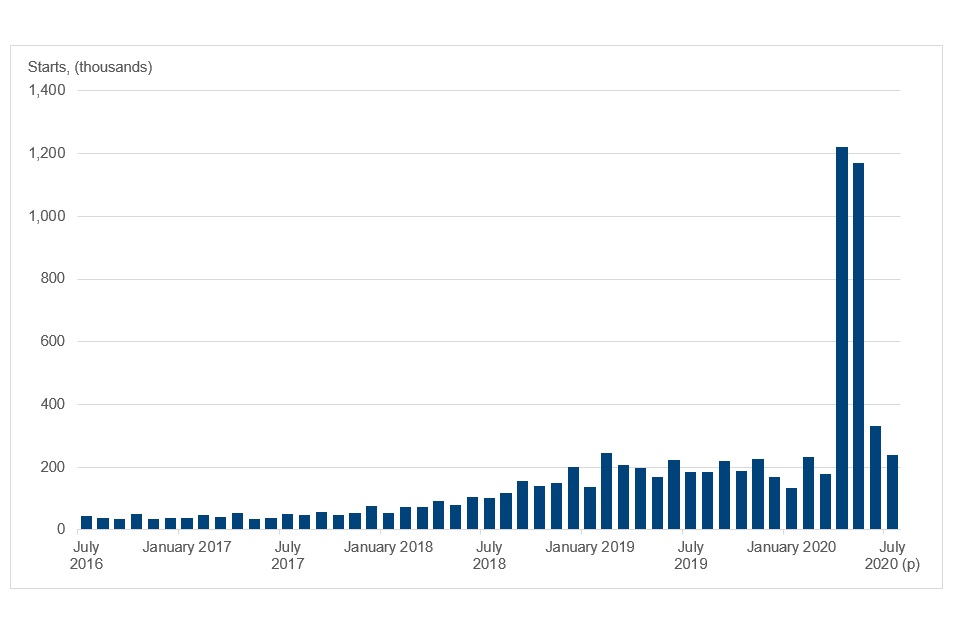
Source: DWP Universal Credit statistics.
Note: See Stat-Xplore for the complete data series.
As a result of the coronavirus pandemic, starts increased to 1.2 million in both April 2020 and May 2020. This figure is 6 times more than the average number of starts in the 12 months to March 2020.
Since May 2020, they have returned to usual levels with 240 thousand starts in the 4 weeks to 9 July 2020. (figure 3).
Starts will be lower than claims made because, for some claims, there will be a period between the claim being made and the claim starting. Other claims made will not go on to start on Universal Credit.
Men were a higher proportion of claimants starting on Universal Credit at the beginning of the coronavirus pandemic
Figure 4: Starts to Universal Credit by gender, July 2016 to July 2020
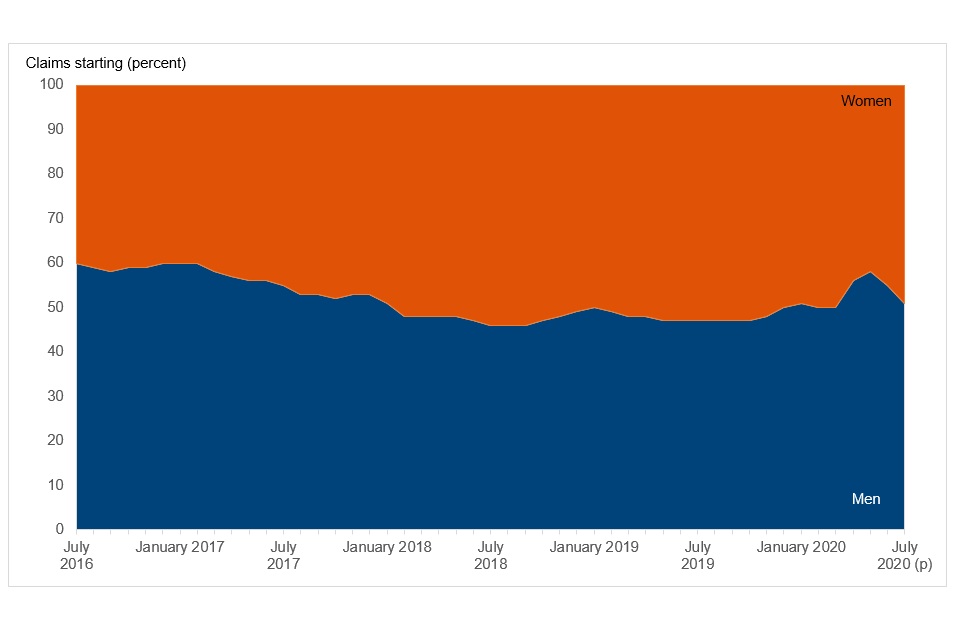
Source: DWP Universal Credit statistics.
Note: See Stat-Xplore for the complete data series.
The coronavirus pandemic has caused a proportional increase in the number of men starting on Universal Credit. For the 5 weeks to 14 May 2020, 58% of starts to Universal Credit were men, compared to around 51% in the most recent 4 weeks to 9 July 2020 (figure 4).
Increase in the proportion of 16 to 24 year olds starting on Universal Credit
Figure 5: Starts to Universal Credit by age group, September 2019 to July 2020
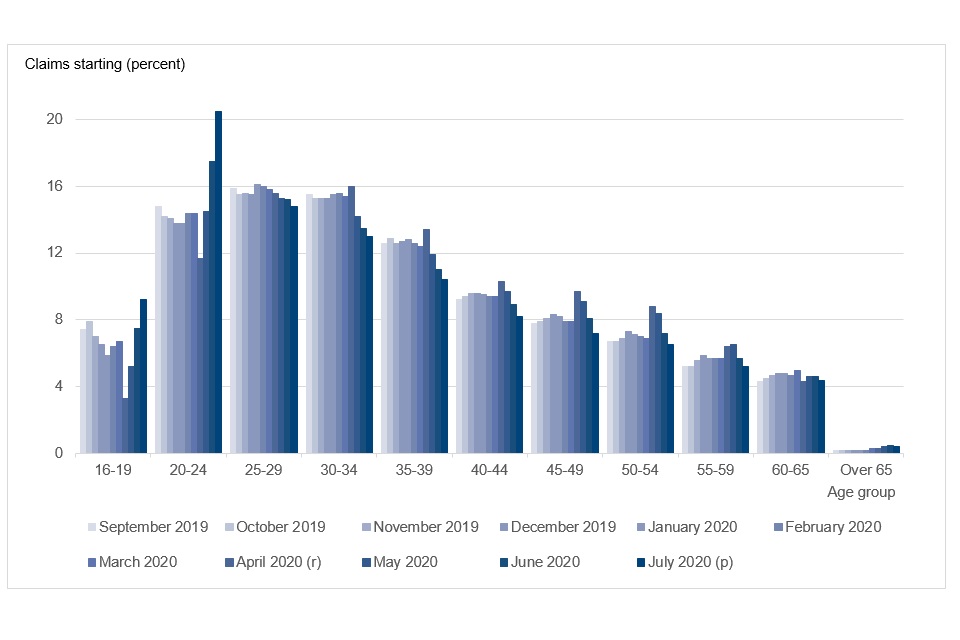
Source: DWP Universal Credit statistics.
Note: See Stat-Xplore for the complete data series.
Claimants starting on Universal Credit during the coronavirus pandemic have a different age profile to claimants starting on Universal Credit before the pandemic.
Claimants starting on Universal Credit in the 16 to 19 age group increased to 9.2% in July 2020, compared to 6.7% in March 2020. In the 20 to 24 age group claimants starting on Universal Credit increased to 20.5% in July 2020, compared to 14.4% in March 2020 (figure 5).
This contrasts with the early stages of the pandemic following the lockdown when these age groups fell as a proportion of those starting on Universal Credit (in April 2020, the 16 to 19 age group fell to 3.3% and the 20 to 24 age group fell to 11.7%).
Claimants starting on Universal Credit in the early stages of the pandemic were typically in the older age groups compared with before the coronavirus pandemic. Claimants in the 45 to 49 age group increased to 9.7% in April 2020 from 7.9% in March 2020. Claimants in the 50 to 54 age group increased to 8.8% in April 2020 from 6.9% in March 2020.
6. People on Universal Credit
People on Universal Credit counts the number of people with an open claim on the count date who had accepted a claimant commitment and verified their identity. Not every person on Universal Credit on the count date will go on to receive a payment for the assessment period.
There were 5.6 million people on Universal Credit at 9 July 2020. This is an increase of 2% from 11 June 2020.
Sharp increase in people on Universal Credit at the beginning of the coronavirus pandemic
Figure 6: People on Universal Credit, July 2015 to July 2020

Source: DWP Universal Credit statistics.
Note: See Stat-Xplore for the complete data series.
Figures marked (p) are provisional; figures marked (r) have been revised since the previous release.
The growth in people on Universal Credit has slowed following the sharp rise at the beginning of the coronavirus pandemic. The number of people on Universal Credit increased 2% in July 2020 from June 2020, compared to an increase of 40% between March and April 2020 (figure 6).
Nearly 1 million people remain on Universal Credit having made a claim during the first month of lockdown
Figure 7: People on Universal Credit by duration, June 2020 to July 2020
| Duration on Universal Credit | June 2020 (r) | July 2020 (p) | Change |
|---|---|---|---|
| Up to 3 months | 2,500,000 | 1,500,000 | -1,000,000 |
| 3 months up to 6 months | 500,000 | 1,500,000 | 1,000,000 |
| More than 6 months | 2,400,000 | 2,500,000 | 0 |
Source: DWP Universal Credit statistics.
Note: See Stat-Xplore for the complete data series.
Components may not sum to total due to rounding. Figures marked (p) are provisional; figures marked (r) have been revised since the previous release.
Over 50% of the 5.6 million people have been on Universal Credit for up to 6 months. This includes the people that claimed Universal Credit since the beginning of lockdown.
Those that applied during the first month of the lockdown would have been on Universal Credit for approaching 4 months. Around 28% of people on Universal Credit having been claiming for up to 3 months and 27% have been claiming for 3 months up to 6 months. Almost 1 million claimants have moved from being on Universal Credit for up to 3 months to the 3 to 6 months’ category between June and July (figure 7).
Universal Credit full service was available in every area of GB by December 2018 when Universal Credit replaced the legacy benefits for new claims for most people. The number of people on Universal Credit has continued to increase since then as people start new claims, and existing claimants’ change in circumstances move them onto Universal Credit.
More women than men on Universal Credit
Figure 8: People on Universal Credit by gender, July 2015 to July 2020
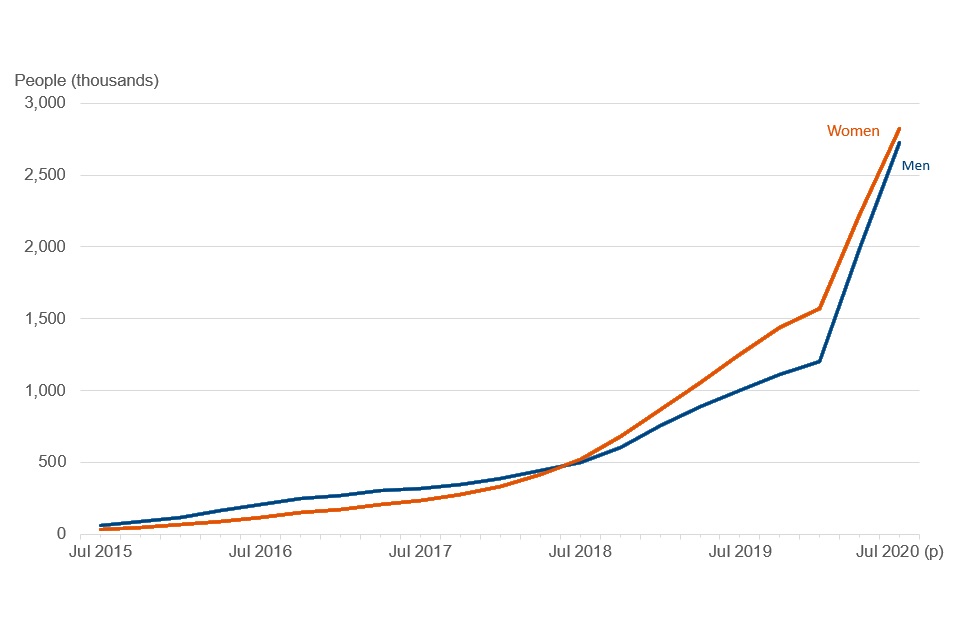
Source: DWP Universal Credit statistics.
Note: See Stat-Xplore for the complete data series.
Figures marked (p) are provisional; figures marked (r) have been revised since the previous release.
There are more women claiming Universal Credit than men at 9 July 2020. However, the proportion of men on Universal Credit has continued to increase since the start of the coronavirus pandemic, at 49% on 9 July 2020 from 44% on 12 March 2020 (figure 8).
From the introduction of Universal Credit up until May 2018, men on Universal Credit outnumbered women on the benefit. Since May 2018, this has changed to women outnumbering men. This change is explained by Universal Credit being only available to working age individuals with no children and whom were seeking employment in the initial introduction of Universal Credit. This group of people are those that would have claimed income related Jobseekers Allowance, which is a benefit that has been typically claimed by men more than women (source: Stat-Xplore).
The broadening of Universal Credit to the people who would have claimed the other legacy benefits has led to more females than men claiming Universal Credit. These benefits, which include Income Support and Child Tax Credit, tended to have been claimed by women.
Younger age groups have increased in proportion in July 2020
Figure 9: People on Universal Credit by age group, September 2019 to July 2020
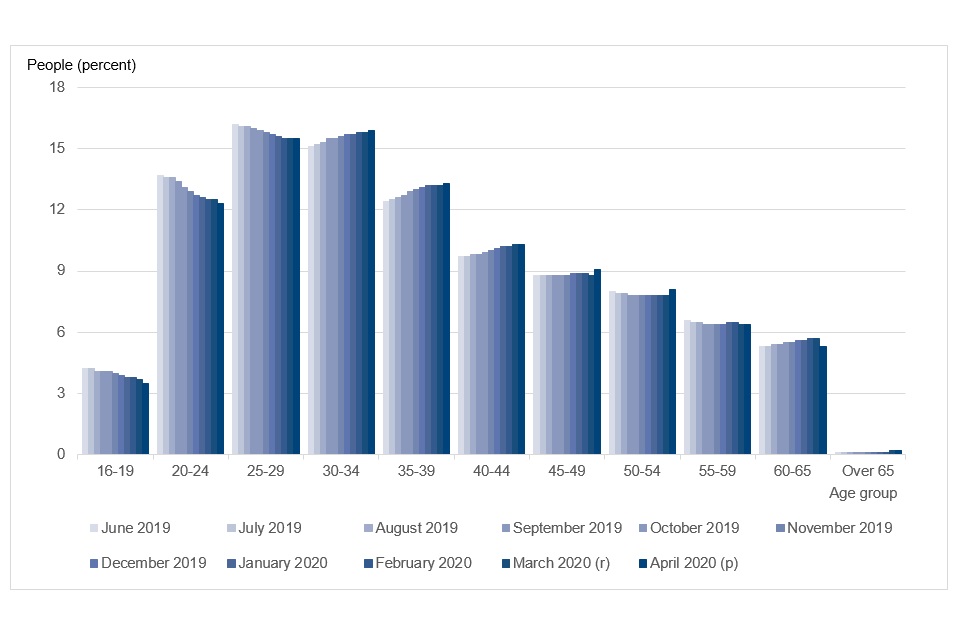
Source: DWP Universal Credit statistics.
Note: See Stat-Xplore for the complete data series.
The proportion of claimants aged 20 to 24 has increased to 13.1% on 9 July 2020 from 12.9% in June 2020 (figure 9), reflecting the higher proportion of starts in this age group (figure 5).
However, although there has been a higher proportion of starts in the 16 to 19 age group, the proportion of people in this age group on Universal Credit has not increased and remains below the level before the coronavirus pandemic (3.5% in July 2020 compared with 3.7% in March 2020).
‘Searching for work’ conditionality regime increased at beginning of coronavirus pandemic
Claimants are required to do certain work-related activities to receive Universal Credit. These activities are determined by which of the 6 conditionality regimes the claimant is placed in. The conditionality regime also determines the level of contact with the claimant, and the support that they will receive.
Conditionality regime is used in Universal Credit statistics instead of terms ‘conditionality group’ and ‘labour market regime’. To help users understand the different regimes more easily, this bulletin uses different terms to the official terms for the labour market regimes. The definitions section of this bulletin provides more information on the different conditionality regimes, and their associated conditionality groups and labour market regimes.
Different members of the same household may be subject to the same or different requirements. As circumstances change claimants will also transition between different levels of conditionality. This means that there is a ‘flow’ of claimants between these groups, that is the number of claimants in each group is constantly changing in our published statistics, month to month.
Figure 10: People on Universal Credit by conditionality regime, July 2016 to July 2020
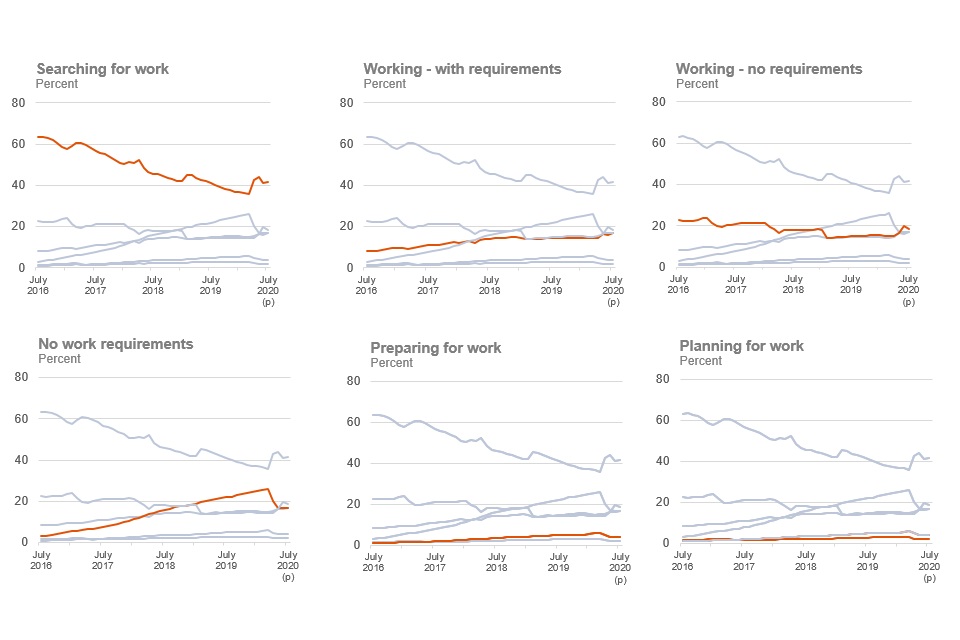
Source: DWP Universal Credit statistics.
Note: See Stat-Xplore for the complete data series.
Percentages may not add up to 100 due to rounding. Figures marked (p) are provisional; figures marked (r) have been revised since the previous release.
The ‘Searching for work’ conditionality regime has increased to 42% of all people on Universal Credit from 36% in March 2020.
Prior to the coronavirus pandemic, the ‘Searching for work’ conditionality regime was on a long term downward trend, from 63% in July 2016. This was because Universal Credit was initially only available to people who were expected to be jobseekers. As Universal Credit has broadened to people that would have claimed other legacy benefits through the introduction of full service the ‘Searching for work’ conditionality regime has fallen as a proportion of the overall caseload.
On 20 March 2020, the Chancellor announced a package of support for workers. This included a £1,000 increase to the standard allowance for Universal Credit for 1 year. This has made Universal Credit more easily available to those isolating and not eligible for Statutory Sick Pay. This, and the unique situation of the coronavirus pandemic in restricting people’s opportunities for work, has led to an increase to the ‘Searching for work’ conditionality regime.
During the coronavirus pandemic, a claimant’s requirement to search for work is tailored towards their individual circumstances. This takes into account their personal circumstances, government health advice and their ability to work. Through an easement, work-related requirements can be ‘turned off’ either by a legal requirement or on a discretionary basis in response to the claimant’s particular circumstances.
The ‘No work requirements’ conditionality regime has fallen markedly as a proportion of people on Universal Credit to 17% from 26% in March 2020. Prior to the coronavirus pandemic, the ‘No work requirements’ conditionality regime had steadily increased in proportion, from 3% in July 2016 (figure 10).
The ‘Working – no requirements’ conditionality regime has increased to 1 million (19%) of people on UC from 500,000 (15%) in March 2020.
The conditionality regime measures which regime an individual is in on the count date. This may not be representative of the entire assessment period for that individual. Conditionality regime figures are not the same as the employment measures, which shows whether an individual has had earnings during their assessment period. The two measures should only be used together with caution. The background information and methodology document provides more information on this.
Increasing proportion of ‘Searching for Work’ not in employment
Figure 11: People on Universal Credit in employment by conditionality regime, June 2016 to June 2020
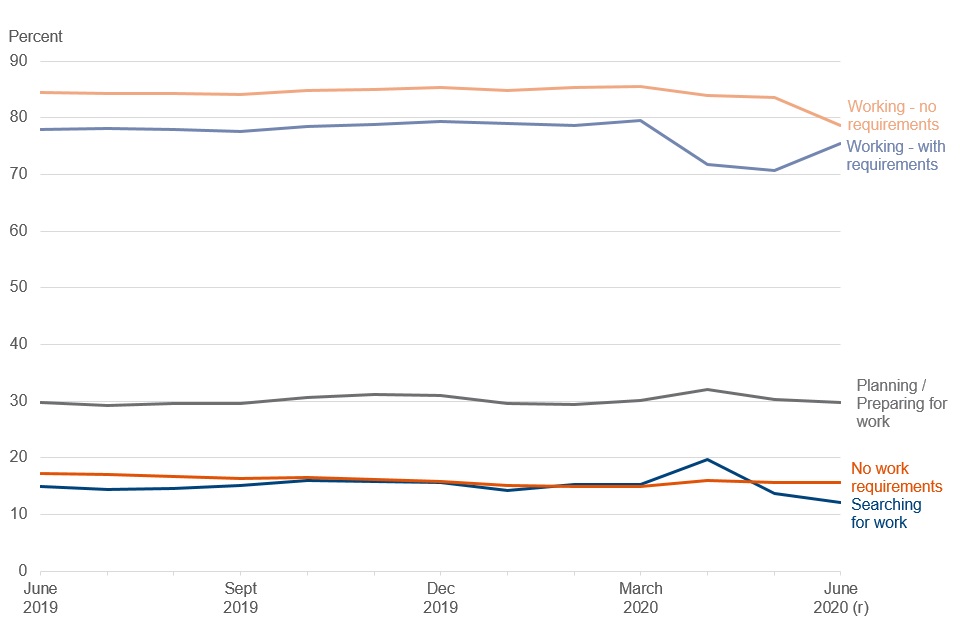
Source: DWP Universal Credit statistics.
Note: See Stat-Xplore for the complete data series.
Percentages may not add up to 100 due to rounding. Figures marked (p) are provisional; figures marked (r) have been revised since the previous release.
A claimant’s conditionality regime may not be apparent from their employment status. There are differences between how conditionality regime and employment status are measured that means the conditionality regime is a measure of the regime the claimant is on the count date.
Employment status measures whether a claimant has received any (PAYE) earnings during the assessment period that covers the count date. For this reason, a claimant may not necessarily be in employment on the count date.
In the ‘Searching for work’ conditionality regime, 88% of claimants received no earnings and are recorded as not in employment for the assessment period covering 11 June 2020. Typically, around 85% of claimants received no earnings and were recorded as not in employment in the months before the coronavirus pandemic.
This means that 12% are recorded as having received earnings and being in employment. These claimants will include those whom are in work with earnings below £338 per month, or with earnings below this level and household earnings below £541 per month. These amounts are known as Administrative Earnings Level (AET) (figure 11)
In the ‘Working - no requirements’ regime there are 79% of claimants in employment. There are 21% of claimants who are recorded as not having received earnings and not in employment. These include claimants who are not in work, but who are in a household with earnings above the household Conditionality Earnings Threshold (CET). The CET is the amount of the National Minimum Wage for the claimant’s expected hours of work.
In a couple household, if one of the adults is earning above the household CET, then the claimant is placed in the ‘Working - no requirements’ regime regardless of the individual employment status. The household CET is a combination of both adults individual CETs.
London and the South East have the largest growth in claimants during the coronavirus pandemic
Figure 12: People on Universal Credit has increased by differing amounts between March 2020 and July 2020 for the regions shown
| Region | % |
|---|---|
| North East | 57 |
| North West | 70 |
| Yorkshire and The Humber | 74 |
| East Midlands | 87 |
| West Midlands | 74 |
| East of England | 97 |
| London | 107 |
| South East | 105 |
| South West | 88 |
| Wales | 71 |
| Scotland | 78 |
Source: DWP Universal Credit statistics.
There have been regional disparities in the growth of Universal Credit during the pandemic. London (107%) and the South East (105%) have seen the largest growth since 12 March 2020, more than doubling the number of people on Universal Credit in those regions. The North East has seen the smallest growth with a 57% increase in the number of people on Universal Credit (figure 12).
Claimants from London make up a greater proportion of people on Universal Credit
Figure 13: People on Universal Credit by region, January 2020 to July 2020

Source: DWP Universal Credit statistics.
Note: See Stat-Xplore for the complete data series.
This growth has returned London to the region with the largest proportion of claimants on Universal Credit. The proportion of people on Universal Credit from London increased to 16.1% on 9 July 2020 from 14.4% on 12 March 2020. This is despite there being proportionally more claimants from some other regions making a Universal Credit claim during the first month of the pandemic. London initially dropped to 13.7% on 9 April 2020 (figure 13).
The South East has also seen a large growth of claimants with 11.6% of people on Universal Credit on the 9 July 2020, an increase from 10.4% on 12 March 2020.
For more regional and local level information see the map for claimants on Universal Credit at Jobcentre Plus office level
7. Households on Universal Credit
In Universal Credit statistics a household is a single person or couple living together with or without dependent children. This is sometimes referred to as a benefit unit in other statistics. To be counted in the ‘households on Universal Credit’ series, a household needs to have had their entitlement calculated for the assessment period covering the count date.
Statistics for ‘households on Universal Credit’ are produced 3 months in arrears. For more information on this and the timeliness of these statistics, refer to the background information and methodology document.
There were 4.2 million households on Universal Credit in May 2020, an increase of 1.7 million since February 2020.
Of these households, 88% (3.7 million) were receiving a payment, compared to 94% (2.4 million out of 2.6 million) in February 2020.
Figure 14: Total households on Universal Credit by in payment and not in payment, May 2016 to May 2020
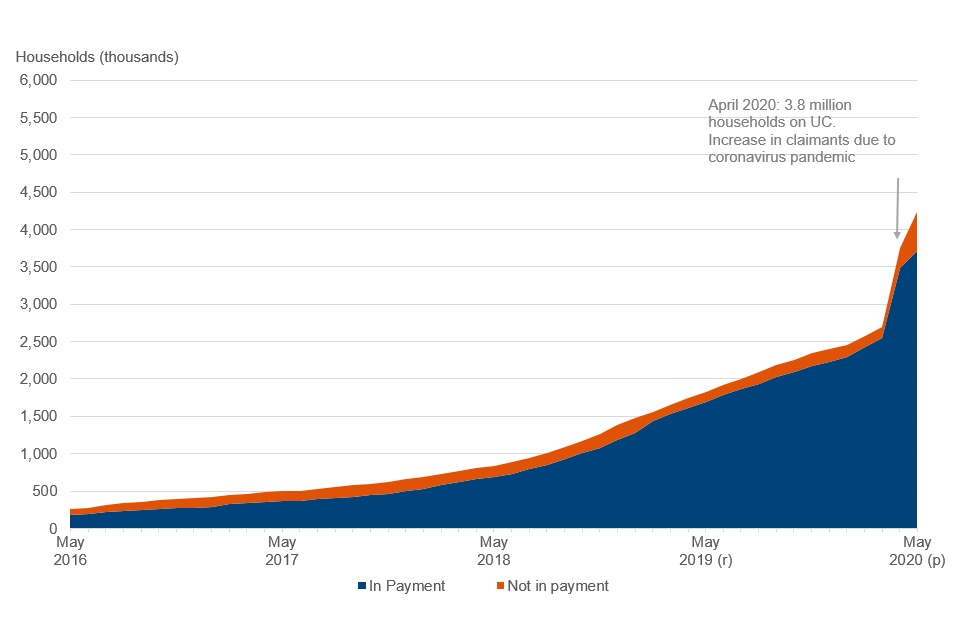
Source: DWP Universal Credit statistics.
Note: See Stat-Xplore for the complete data series.
Figures marked (p) are provisional; figures marked (r) have been revised since the previous release.
There are a number of reasons why a household may not be in receipt of a payment, such as when someone moves into work and their level of earnings means that they no longer receive a payment.
Around 88% of households on Universal Credit were in payment in May 2020
Figure 15: Households on Universal Credit in-payment, May 2016 to May 2020

Source: DWP Universal Credit statistics.
Note: See Stat-Xplore for the complete data series.
Figures marked (p) are provisional; figures marked (r) have been revised since the previous release.
There was a fall in the proportion of households in-payment in May 2020 compared with the previous quarter. (figure 15)
Nil payment claims are normally closed if the claimant’s earnings reduce their award to nil. However, as a temporary process change during the coronavirus pandemic where a claim would normally be closed as a result of high earnings, these claims are temporarily being kept open for up to 6 assessment periods of nil payment.
In addition, households would have claimed Universal Credit at the beginning of the coronavirus pandemic before other support measures were announced. As the Job Retention Scheme and other support measures were announced and came into effect, their earnings may not have fallen as much as the claimant initially anticipated when making a claim for Universal Credit. Consequently, their award was tapered down to nil by their earnings.
The average payment increases as Universal Credit is paid to a broader range of households.
The amount of Universal Credit a household receives is based on the standard Universal Credit entitlement plus additional entitlements that they are eligible for. Above these entitlements households may also receive additional payments for a loan advance, hardship payment, severe disability payment or mortgage interest.
The payments will be lower than their Universal Credit entitlements where the household is making a loan repayment, has been sanctioned, is limited by the benefit cap, is having benefit or tax credit overpayments being recovered or their income is above the threshold where the payment is reduced by the taper.
Average payment increases due to increased standard allowance and advances
Figure 16: Average (mean) payment for in-payment households, May 2016 to May 2020

Source: DWP Universal Credit statistics.
Note: See Stat-Xplore for the complete data series. Figures marked (p) are provisional; figures marked (r) have been revised since the previous release.
The average (mean) amount of Universal Credit paid to households on Universal Credit was £780 per month in May 2020. This is an increase of £90 from £690 per month a year earlier. The increase in the average award is due to annual uprating of Universal Credit entitlements and an additional, temporary, £1,040 a year to the standard allowance in response to the coronavirus pandemic. (figure 16)
Additionally, payment awards would have increased from a suspension of the recovery of debts from Universal Credit and legacy benefit overpayments, Social Fund loans and Tax Credits. The recovery of these debts was suspended until early May 2020.
The average payment is influenced by large payments. Nearly 8% of households where Universal Credit is in payment are paid more than £1,500. The average (mean) payment is increased by these large payments, which are largely caused by households receiving payments in addition to their standard entitlements.
In May 2020, the median payment – the amount where 50% of households are paid more, and 50% of households are paid less than - is lower than the average (mean) payment at £690 (figure 17). This compares with a median of £610 in May 2019.
The average payment for May 2020 is £60 lower than the £840 in April 2020. This was caused by advances being paid to some of the 1.5 million new claimants in the 4 weeks to 9 April 2020. Data on advances are not published in official statistics, however management information on advances during the initial period of the coronavirus pandemic is published.
Average (mean) payment is influenced by a number of high payments
Figure 17: Payments by payment band, May 2020
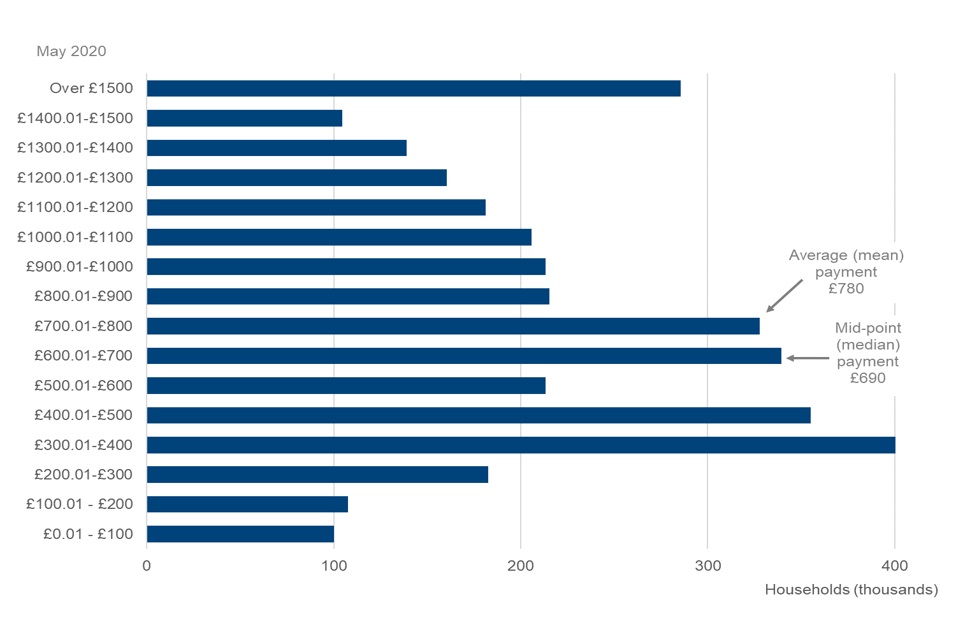
Source: DWP Universal Credit statistics.
Note: See Stat-Xplore for the complete data series. Figures marked (p) are provisional.
More households were awarded a payment in the £300.01 to £400 payment band than any other payment band (figure 17). Over 90% of claimants in this payment band were single claimants without children. In contrast, in the over £1,500 payment band, 90% were households with children (Source: Stat-Xplore).
The £300.01 to £400 is the largest payment band in every region except London. In London the largest payment band is the Over £1,500 payment band with 17% (100,000) households in this payment band. Over 97% of these households are claiming the housing element.
Of all households with a payment of over £1,500, nearly 39% are in London. Over 50% of households with a payment of over £1,500 are in London and the South East. (Source: Stat-Xplore)
For more regional data, refer to the household dashboard and household maps at region and local authority level
Increased proportion of households in payment are without children since beginning of coronavirus pandemic
Figure 18: Households by family type (%), February 2017 to April 2017
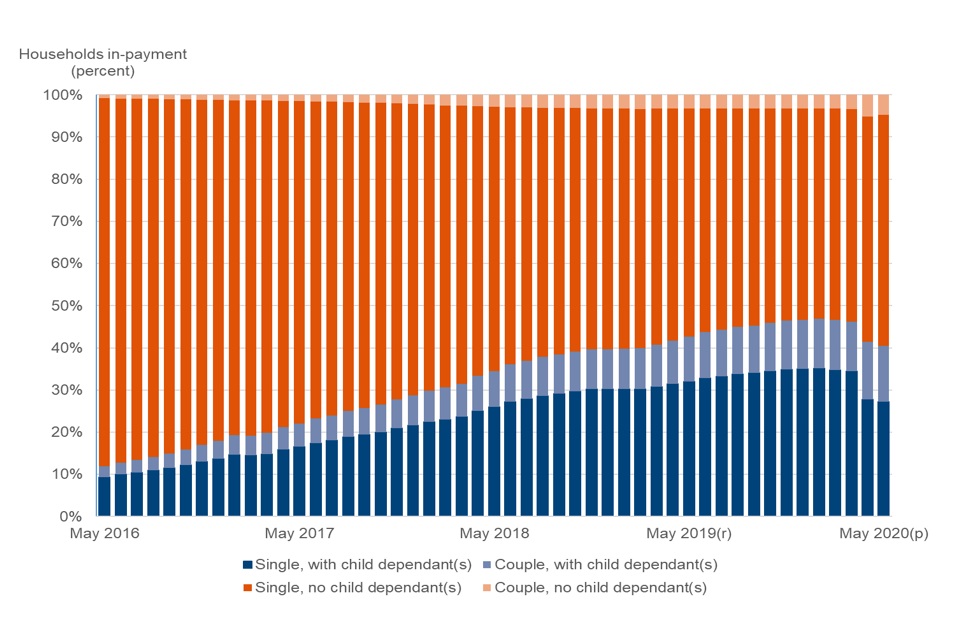
Source: DWP Universal Credit statistics.
Note: This chart only includes households where Universal Credit is in payment. See Stat-Xplore for the complete data series. Percentages may not add up to 100 due to rounding. Figures marked (p) are provisional; figures marked (r) have been revised since the previous release.
There has been an increase in the proportion of households without children on Universal Credit claims in payment since the beginning of the coronavirus pandemic (59% in May 2020 compared to 53% in March 2020).
Prior to the coronavirus pandemic there was a long term upward trend for the proportion of households with children on Universal Credit claims in payment. This was because Universal Credit had replaced legacy benefits and tax credits for new claims and migration from tax credits due to a change in circumstances (figure 18).
All additional entitlements have fallen as a proportion of households in-payment
Figure 19: Entitlements, June 2017 to May 2020
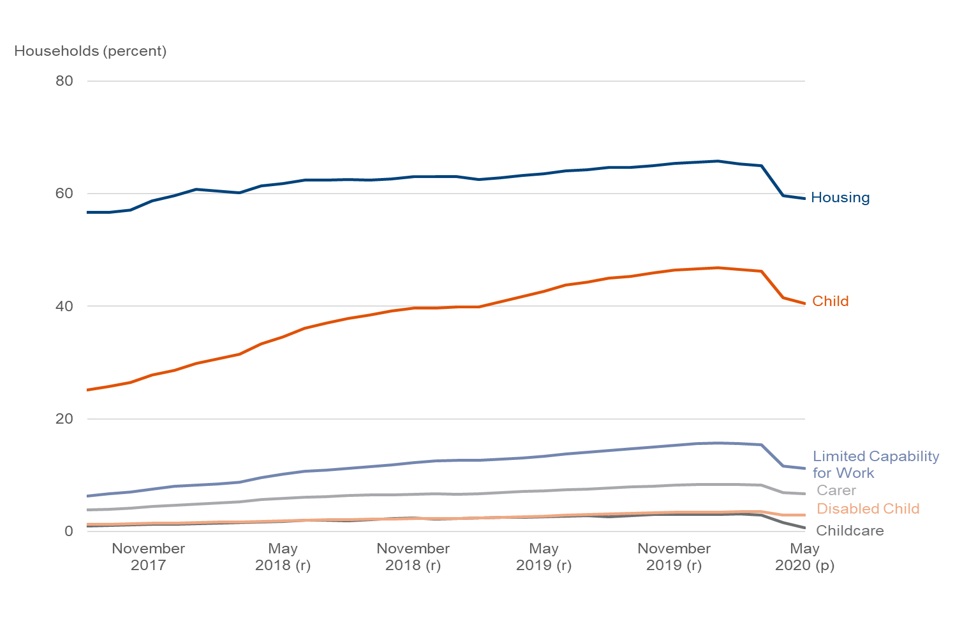
Source: DWP Universal Credit statistics.
Note: This chart only includes households where Universal Credit is in payment. See Stat-Xplore for the complete data series. Figures marked (p) are provisional; figures marked (r) have been revised since the previous release.
There are a range of additional entitlements in Universal Credit payments for children, health and disabilities, housing and carers. The proportion of Universal Credit payments with each of these entitlements has decreased as a result of an increase in claimants from the coronavirus pandemic. This suggests a greater proportion of new claimants are not claiming additional entitlements.
This follows a period where the proportion of claimants with additional entitlements was increasing as Universal Credit gradually replaces legacy benefits for new claims. (figure 19).
Entitlement for housing is included in the majority of awards to households in payment, with 59% of payment awards including this element in May 2020, down from a peak of 66% in January 2020. It was 54% in May 2017.
The child entitlement is included in over two in five households in payment, with 41% of these awards including this entitlement in May 2020, compared with 43% a year earlier and 22% in May 2017. It peaked at 47% in January 2020.
98% of households in-payment received their full payment on time in April 2020
Statistics on payment timeliness are produced a further month in arrears to avoid large revisions to provisional figures caused by retrospection. This is to allow for more accurate and higher quality statistics.
Figure 20: Payment timeliness (all claims), October 2017 to April 2020
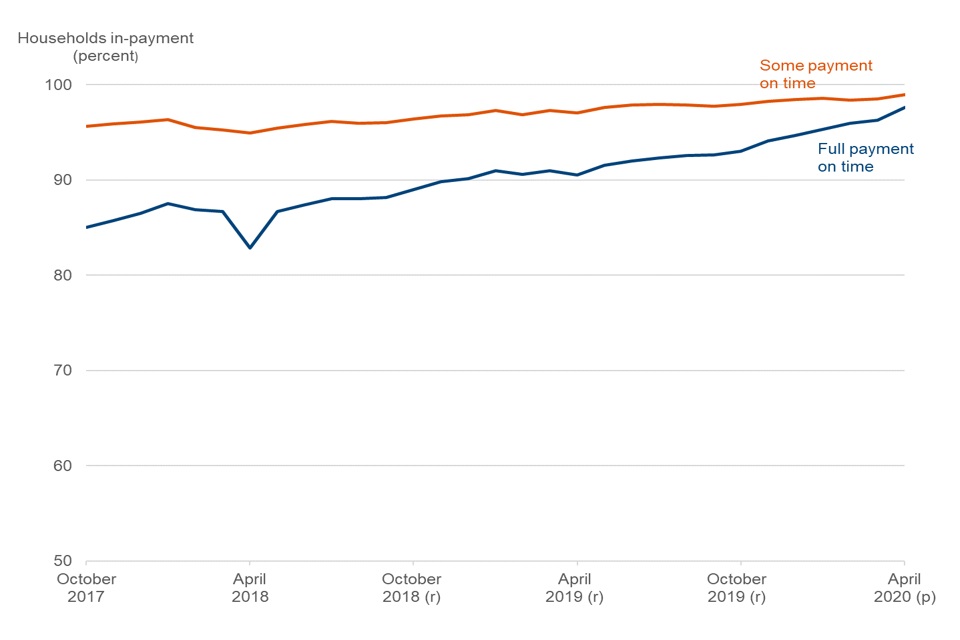
Source: DWP Universal Credit statistics.
Note: Payment timeliness statistics are available in Stat-Xplore from April 2019 onwards. To allow sufficient time for information to be gathered on all payments, figures are not included for the latest month in the series. Payment timeliness statistics for January 2017 to March 2019 for Universal Credit full service can be found in table 1.1 in the ODS tables accompanying this bulletin. Figures prior to April 2019 are Universal Credit full service only. Figures marked (p) are provisional; figures marked (r) have been revised since the previous release.
In April 2020, the first full assessment period of the coronavirus pandemic, 98% of households in-payment received their full payment on time. This compares to 96% in March 2020, and 91% in April 2019.
Around 99% of households receiving a payment were paid some payment on time, compared to 97% in April 2019 (figure 20)
In the first month of the coronavirus pandemic 96% of households in-payment with a new claim received their full payment on-time
Figure 21: Payment timeliness (new claims), October 2017 to April 2020

Source: DWP Universal Credit statistics.
Note: Payment timeliness statistics are available in Stat-Xplore from April 2019 onwards. To allow sufficient time for information to be gathered on all payments, figures are not included for the latest month in the series. Payment timeliness statistics for January 2017 to March 2019 for Universal Credit full service can be found in table 1.1 in the ODS tables accompanying this bulletin. Figures prior to April 2019 are Universal Credit full service only. Figures marked (p) are provisional; figures marked (r) have been revised since the previous release.
Payment timeliness is lower for new claims when compared with all claims. There are a number of one-off verification processes that must be completed by the claimant and by DWP at the start of the claim.
These are to confirm the current circumstances of the claimant (or both claimants in a joint claim) and their entitlement to Universal Credit. Delays to completion of these processes can cause payments to not be made on time.
There was an increase to 96% of in-payment new claims receiving the full award on time during April 2020. These would include all new claims that were made in the first month of the coronavirus pandemic, including the initial stages of the lockdown. This compares with 88% in March 2020 and 79% in April 2019 (figure 21).
The increase in payment timeliness for new claims was achieved by DWP making several operational changes. These include introducing a new identity verification service and moving staff to process benefits. A process called “don’t call us, we’ll call you” was also introduced where claimants would be contacted via telephone if information was needed to process their claim.
Around 98% of in-payment new claims received some of the payment on time in April 2020. This compares with 92% in March 2020 and 88% in April 2019.
8. About these statistics
Purpose
These statistics provide the primary official source of information about people and households on Universal Credit, and claims and starts to Universal Credit.
They enable a variety of users to be informed about different elements of the benefit including politicians, policy and administrative staff in central and local government, academics, the voluntary sector and journalists. They use the statistics for a range of purposes from monitoring and accountability to research and policy development. The background information and methodology document includes more details on the users and uses of these statistics.
User engagement and development of these statistics
These official statistics have been compiled using data from systems within local offices and records of Universal Credit benefit payments made by the department.
These and other new data sources will, in time, allow a progressively broader range of breakdowns to be published as data sources are developed. The methodology used and definitions of the official statistics may be updated within subsequent releases, along with information on the impact of any changes to the time series already released.
A strategy for the release of official statistics on Universal Credit was first published in September 2013 and last updated in January 2018 following consultation with users.
Compliance check against the Code of Practice for Statistics
These statistics have been developed using guidelines set out by the UK Statistics Authority and are official statistics that are experimental.
A compliance check was conducted on Universal Credit statistics by the Office for Statistics Regulation (OSR) in May 2019. They welcomed many aspects of the release and made a number of recommendations to support the development of these experimental statistics.
Since that compliance check we have introduced a number of developments. The background information and methodology contains more details on these.
Users are invited to comment on the content, relevance, accessibility and timeliness of these statistics by sending an email to team.ucos@dwp.gov.uk or on the Welfare and Benefits statistics board of StatsUserNet.
Rounding
Volumes and amounts have been rounded as detailed in the background information and methodology document. Percentages are calculated using numbers prior to rounding and rounded to the nearest whole percentage point.
Revisions
Universal Credit statistics are subject to scheduled revisions as detailed in the background information and methodology document.
Postcode areas in claims made to Universal Credit for 13 March 2020 to 9 April 2020 and starts on Universal Credit for April 2020 have been made. For more information refer to the statistical notice published alongside this bulletin.
9. Related statistics
This publication complements other statistics bulletins that, together, provide a more coherent view of Universal Credit claimants and awards, and other benefits.
Universal Credit statistics for Northern Ireland are published by the Department for Communities (Northern Ireland).
Benefit sanctions includes statistics on people having their award stopped or reduced for not meeting their agreed conditions.
Benefit Cap includes statistics on people who have had their Universal Credit award capped because their total amount received in benefits is higher than the maximum amount of benefits a person can receive.
DWP benefits provides statistics for benefits that Universal Credit is replacing.
Fraud and error in the benefit system provides estimates of the number of households that may have been paid too much Universal Credit or not enough. These overpayments and underpayments happen as a consequence of fraud; claimant error; and official error (processing errors or delays by DWP, a Local Authority, or Her Majesty’s Revenue and Customs). ‘Fraud and error in the benefit system’ estimates how much money the department incorrectly pays.
Claimant count is a measure of the number of people claiming benefits principally for the reason of being unemployed, based on administrative data from the benefits system. It includes people on Universal Credit in the searching for work conditionality regime for the UK. Universal Credit statistics uses the same data excluding Northern Ireland.
Alternative claimant count statistics measure the number of people claiming unemployment related benefits by modelling what the count would have been if Universal Credit had been fully available from when Universal Credit was introduced in 2013 with the broader span of people this covers. Under Universal Credit, a broader span of claimants are required to look for work than under Jobseeker’s Allowance. This is a feature of the design of Universal Credit and has the effect of increasing the Claimant count irrespective of how the economy performs. For this reason, the Office for National Statistics have stated that the Claimant count figures are no longer a reliable indicator of the labour market. The Alternative claimant count attempts to address this.
European Social Fund 2014 - 2020 (ESF 14-20) programme is an EU-funded employment, skills and social inclusion programme across England aimed at providing the help people need to achieve their potential. This publication uses Universal Credit data to show how many people who started on the programme were on Universal Credit.
10. Definitions
Claim made
A claim made is when an individual submits an application for Universal Credit.
Start
A person has started on Universal Credit when their identity has been verified and they have agreed their claimant commitment.
People
A person is counted on Universal Credit when they have met the definition to start, they have a National Insurance number recorded and there is no record of a closure of the claim.
Household and in-payment
A household is a single person or co-habiting couple with or without dependant children. A household is counted when their assessment period overlaps the count date. An in-payment household is one that has received a Universal Credit payment of £0.01 or more after deductions, sanctions and the benefit cap during that assessment period.
Conditionality Regimes
All people on Universal Credit are placed into one of four conditionality groups, depending on their personal circumstances. Which of these groups they are placed into will determine what activities they are required to do (if any) as part of their claim. Universal Credit statistics uses the term conditionality regime in place of ‘conditionality group’ and ‘labour market regime’. The table below shows the circumstances of individuals for each conditionality regime and the associated group and labour market regime.
| Conditionality regime | Description | Conditionality Group | Labour Market Regime |
|---|---|---|---|
| Searching for work | Not working, or with very low earnings. Claimant is required to take action to secure work - or more or better paid work. The Work Coach supports them to plan their work search and preparation activity. Typical examples of people in this regime include jobseekers and self-employed in start-up period. Claimants are only in this regime if they do not fit into one of the other regimes. | All work related requirements | Intensive Work Search |
| Working – with requirements | In work, but could earn more, or not working but has a partner with low earnings. | All work related requirements | Light touch |
| No work requirements | Not expected to work at present. Health or caring responsibility prevents claimant from working or preparing for work. Examples of people on this regime include those in full time education, over state pension age, has a child under 1 and those with no prospect for work. | No work related requirements | No work related requirements |
| Working – no requirements | Individual or household earnings over the level at which conditionality applies. Required to inform DWP of changes or circumstances, particularly at risk of earnings decreasing or job loss. | No work related requirements | Working enough |
| Planning for work | Expected to work in the future/ Lead parent or lead carer of child aged 1 (aged 1 to 2, prior to April 2017). Claimant required to attend periodic interviews to plan for their return to work. | Work focused interview | Work focused interview |
| Preparing for work | Expected to start work in the future even with limited capability to work at the present time or a child aged 2 (aged 3 to 4, prior to April 2017). Claimant expected to take reasonable steps to prepare for working including Work Focused Interview. | Work preparation | Work preparation |
Universal Credit live service
The original service offering Universal Credit. Initially restricted to mostly single working age people with no children, seeking work. It was available throughout Great Britain by May 2016. It closed to new claims from 1 January 2018 and all remaining claimants were moved to full service by March 2019.
Universal Credit full service
Full service is the digital system that offers Universal Credit to the full range of claimant groups. New claims are made on gov.uk and most accounts are managed only through an online account. It was gradually introduced to Jobcentres from 2016 and was available in every Jobcentre across Great Britain and Northern Ireland by December 2018. When full service became available in a Jobcentre, existing Universal Credit claimants on live service were transferred to full service within 3 months.
A glossary for further terms used in Universal Credit statistics is included in the background and methodology document.
11. Contacts
Feedback on the content, relevance, accessibility and timeliness of these statistics and any non-media enquiries should be directed to:
Statistician: Stephen Slater
Email: team.ucos@dwp.gov.uk
Media enquiries: 0203 267 5129
ISBN: 978-1-78659-197-5
